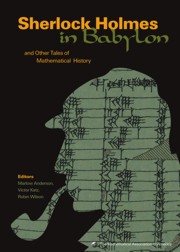Book contents
- Frontmatter
- Introduction
- Contents
- Ancient Mathematics
- Medieval and Renaissance Mathematics
- Foreword
- The Discovery of the Series Formula for π by Leibniz, Gregory and Nilakantha
- Ideas of Calculus in Islam and India
- Was Calculus Invented in India?
- An Early Iterative Method for the Determination of sin 1°
- Leonardo of Pisa and his Liber Quadratorum
- The Algorists vs. the Abacists: An Ancient Controversy on the Use of Calculators
- Sidelights on the Cardan-Tartaglia Controversy
- Reading Bombelli's χ-purgated Algebra
- The First Work on Mathematics Printed in the New World
- Afterword
- The Seventeenth Century
- The Eighteenth Century
- Index
- About the Editors
Ideas of Calculus in Islam and India
from Medieval and Renaissance Mathematics
- Frontmatter
- Introduction
- Contents
- Ancient Mathematics
- Medieval and Renaissance Mathematics
- Foreword
- The Discovery of the Series Formula for π by Leibniz, Gregory and Nilakantha
- Ideas of Calculus in Islam and India
- Was Calculus Invented in India?
- An Early Iterative Method for the Determination of sin 1°
- Leonardo of Pisa and his Liber Quadratorum
- The Algorists vs. the Abacists: An Ancient Controversy on the Use of Calculators
- Sidelights on the Cardan-Tartaglia Controversy
- Reading Bombelli's χ-purgated Algebra
- The First Work on Mathematics Printed in the New World
- Afterword
- The Seventeenth Century
- The Eighteenth Century
- Index
- About the Editors
Summary
Introduction
Isaac Newton created his version of the calculus during the years from about 1665 to 1670. One of Newton's central ideas was that of a power series, an idea he believed he had invented out of the analogy with the infinite decimal expansions of arithmetic [9, Vol. III, p. 33]. Newton, of course, was aware of earlier work done in solving the area problem, one of the central ideas of what was to be the calculus, and he knew well that the area under the curve y = xn between x = 0 and x = b was given by bn + 1/(n + 1). (This rule had been developed by several mathematicians in the 1630s, including Bonaventura Cavalieri, Gilles Persone de Roberval, and Pierre de Fermat.) By developing power series to represent various functions, Newton was able to use this basic rule to find the areas under a wide variety of curves. Conversely, the use of the area formula enabled him to develop power series. For example, Newton developed the power series for y = arcsin x, in effect by defining it in terms of an area and using the area formula. He then produced the power series for the sine by solving the equation y = arcsin x for x = sin y by inversion of the series. What Newton did not know, however, was that both the area formula — which he believed had been developed some 35 years earlier — and the power series for the sine had been known for hundreds of years elsewhere in the world.
- Type
- Chapter
- Information
- Sherlock Holmes in BabylonAnd Other Tales of Mathematical History, pp. 122 - 130Publisher: Mathematical Association of AmericaPrint publication year: 2003
- 2
- Cited by



